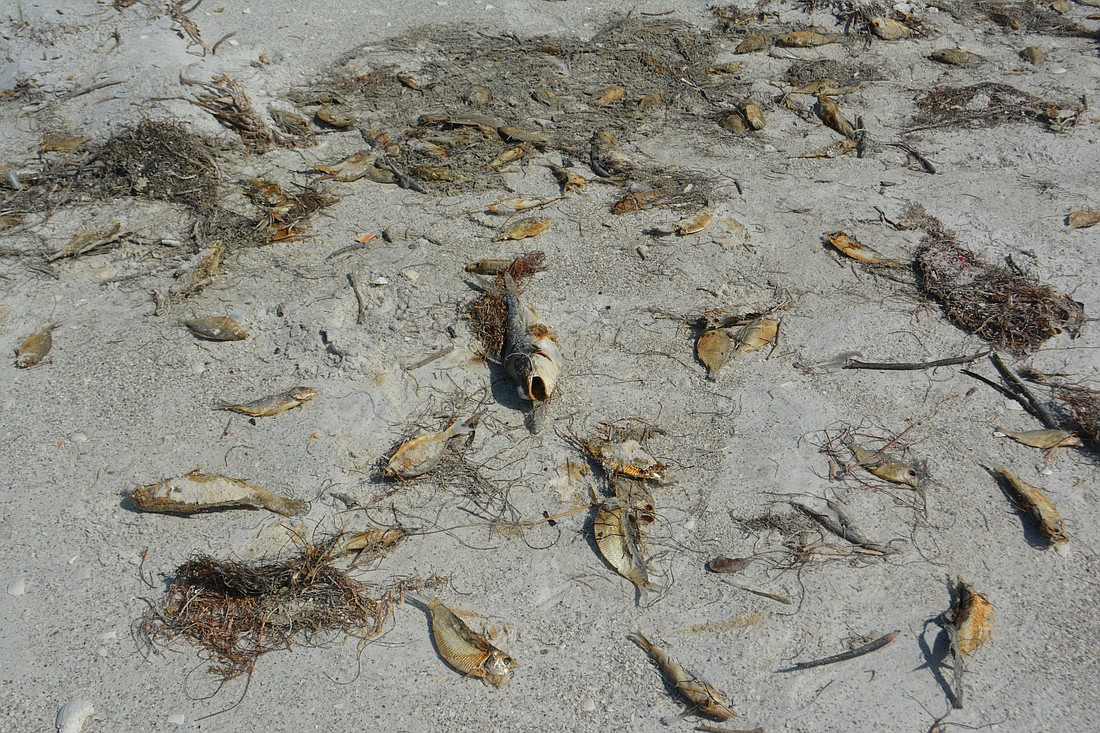- May 23, 2025
-
-
Loading

Loading

As anyone on the Key knows, red tide is still here with uncertainty on when it will pack its bags for a while.
Karenia brevis is the naturally occurring organism that can lead to harmful algal blooms that cause red tide.
Because it is a naturally occurring, mostly ever-present organism, there is not much local officials can do to solve the issue or lessen its effects.
Town commissioners discussed what responsibilities they have when it comes to monitoring red tide, cleaning up dead fish and getting out information to concerned residents and visitors at their March 6 regular meeting.
“It’s affecting everybody I know that stays outside right now,” Commissioner Mike Haycock said. “I have gotten a number of complaints about fish kills and the smell from fish kills.”
Town Manager Howard Tipton said the amount of dead fish on the beaches and in the canals had not met the threshold for a cleanup using town resources.
However, on March 8, town staff sent an email notifying people of Manatee County’s plan to clean up the beaches for the entire 10-mile stretch of the island. The county raked the beach to help the town remove some of the dead sea life.
If the amount of dead sea life on the beaches and in town waters would have been higher, then town staff would have been sent out to assist with the cleanup.
“We coordinate with them weekly on whether they are coming out or not,” Public Works Director Isaac Brownman said.
Public Works has been receiving numerous calls from visitors and residents with concern for the respiratory irritation that is common when spending time outside, near the water during red tide.
“We are keeping an eye on the fish,” he said. “We are fielding a lot of calls and reminding people that even if we clean up that fish today that irritation will be just as bad as it is right now because it has nothing to do with the fish.”
Tipton told commissioners that Hurricane Ian likely had a large effect on the current presence of red tide.
“The concern is it may continue and potentially get worse,” he said.
Commissioner Debra Williams asked Brownman to consider finding ways to get information out to residents and visitors alike about the status of red tide and any future plans the town has for addressing dead fish on the beach.
“People want to know two things,” she said. “They want to know the cleanup cycle, and they want to know how they get the latest information about red tide and what is actually out there.”
Since the discussion, town staff has posted on Twitter about the cleanup efforts and where to look for updates and additional information.
“The opportunity to get our residents and our visitors knowing that (social media) is the place they can go for any information about Longboat Key I think is critical,” Commissioner BJ Bishop said.
The town also addressed red tide in its most recent installment of its video series, Talk of the Town. Tipton sat down with Brownman to discuss red tide and the town’s approach to cleanup and monitoring.
“It hasn’t been as bad as it has been in years past,” Tipton said in the video. “But if you’re new to the town, it can be a little bit of an adjustment.”
“Red tide is something our area has dealt with for generations,” Brownman said. “...It rolls in from time to time and we can’t really predict when it will come in. It can vary from very intense to very minor.”
It is customary for the town to wait several tide cycles to see if the wind and waves naturally remove dead fish and sea life from the shores before coordinating a cleanup.
“Deployment (of town staff) and cleanup of the red tide material by the town is very labor intensive and very challenging,” he said. “There are not a lot of good ways to do it, so we’re very judicious about when we deploy for red tide.”
Brownman explained that residents have an opportunity to help the town cleanup the beaches too. Residents that live along the Gulf of Mexico coast or other beachgoers are permitted to bury the dead fish and other sea life behind their properties in the sand.
It is recommended that holes be dug at least 2 feet deep to ensure waves do not bring the fish back up to the surface.
Tropical storms and hurricanes can make red tide blooms worse and longer lasting.
The combination of heavy rainfall and high winds can cause lawn clippings, fertilizer and overflowing wastewater to end up in bodies of water in the area, causing an increase in the nutrient load and eventually the presence of harmful algal blooms.
“What seems to have happened is this red tide seems to be a continuation of a red tide that really flared up after (Hurricane) Ian came through,” Sarasota Bay Estuary Program Director Dave Tomasko said. “It just never went away.”
There are few ways to predict when a bout of red tide will arrive or when it will leave, but the Florida Fish and Wildlife Conservation Commission provides regular updates to its website. The University of South Florida College of Marine Science has a set of maps that predict the presence of red tide, but only a couple of days out.
Although Karenia brevis is a naturally occurring organism in the Gulf of Mexico and Sarasota Bay, Tomasko said residents can take steps to ensure they are not making the problem worse. Actions to avoid include not over-fertilizing your lawn, cleaning up after pets outside, not blowing lawn clippings in the water or storm drains and properly trimming mangroves.